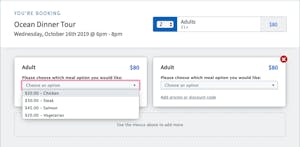- 9 minute read
- Business Management Tips
- Websites
Beginner
Spark is headed to the Big Easy! Join us in New Orleans October 13-15. Registration opens soon!

No matter which pricing strategies are used to sell activities, there’s always room for something extra to help drive revenue and set yourself apart from the competition.
Tour add-ons are additional services or products that guests can add to their tour or activity during the checkout process. These optional tour extras like meals, special offers, upgrades, or products are not included in the base price of the tour and are specific to the tour being booked.
Add-ons are an excellent way to add value to the experiences you offer and facilitate a cohesive booking process. This gives customers confidence knowing they will have everything they need from the moment their booking is completed.
If your tour or activity requires additional items or has specific requirements (for example, that snorkeling guests must use reef-safe sunscreen only), add-ons help ensure that your guests get everything they need before the activity begins.
This guide will detail why you should offer tour add-ons and what kind of products and services can be included as add-ons. You’ll also learn whether add-ons are right for your business and how to avoid creating decision fatigue by adding too many booking options. Plus, we’ll cover some tips and tricks for implementing add-ons in the booking process.
Add-ons can be almost anything imaginable, from meals and transportation to rental gear and more. Here are a few of the most common add-ons:
 Photo/video packages: Is your activity one of those must-photograph adventures? If the tour involves activities that are difficult for guests to photograph (snorkeling or scuba diving, zip-lining, cave rappelling, ATV tours, etc.), providing a professional photography or videography service is a way for guests to capture their experience and create lasting memories. Plus, a photo/video package lets guests focus on living in the moment without having to worry about taking photos of their own.
Photo/video packages: Is your activity one of those must-photograph adventures? If the tour involves activities that are difficult for guests to photograph (snorkeling or scuba diving, zip-lining, cave rappelling, ATV tours, etc.), providing a professional photography or videography service is a way for guests to capture their experience and create lasting memories. Plus, a photo/video package lets guests focus on living in the moment without having to worry about taking photos of their own.Feel free to get creative with add-ons. Think about things that would enhance your guests’ experience or help them get prepared for the tour. If your add-ons will offer great value and set you apart from your competitors, it’s a win-win for your customers and your business.
On the flip side, consider whether tour add-ons are really necessary for your business. Is it absolutely essential that you offer meals or T-shirts? Let’s say you offer hiking tours to a remote area where guests cannot easily find a meal. It’s probably a good idea to offer a meal as an add-on. However, if your booking form already includes many custom fields, you should skip items like T-shirts which can be sold in person at your business. Keep in mind that having too complicated of a booking form can confuse potential bookers and possibly cause them to abandon the booking.

Get started by brainstorming possible add-ons and include them with the most popular tour(s) to see how well they perform. You can always add additional extras or remove whichever ones aren’t selling. Find information on how custom fields are performing by running the Custom Field Answers report in your Dashboard.
For more resources about how to make the most of your bookings see our pricing and up-sell strategies guide.